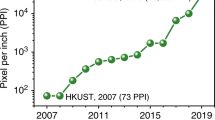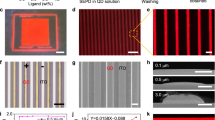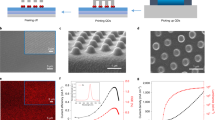Abstract
Highly efficient and high-definition displays with deformable form factors are highly desirable for next-generation electronic devices. Despite the unique advantages of quantum dots (QDs), including high photoluminescence quantum yield, wide colour range and high colour purity, developing a QD patterning process for high-definition pixels and efficient QD light-emitting diodes (QLEDs) is in its early stages. Here we present highly efficient QLEDs through ultrahigh-definition double-layer transfer printing of a QD/ZnO film. Surface engineering of viscoelastic stamps enables double-layer transfer printing that can create RGB pixelated patterns with 2,565 pixels per inch and monochromic QD patterns with ~20,526 pixels per inch. The close packing of both QDs and ZnO nanoparticles by double-layer transfer printing substantially minimizes the leakage current, enhancing the external quantum efficiency of our devices to 23.3%. Furthermore, we demonstrate highly efficient wearable QLEDs fabricated by our technique. This study paves the way for the development of highly efficient, full-colour QD displays via the transfer printing technique, demonstrating great promise for next-generation display technologies.
This is a preview of subscription content, access via your institution
Access options
Access Nature and 54 other Nature Portfolio journals
Get Nature+, our best-value online-access subscription
$29.99 / 30 days
cancel any time
Subscribe to this journal
Receive 12 print issues and online access
$209.00 per year
only $17.42 per issue
Buy this article
- Purchase on SpringerLink
- Instant access to full article PDF
Prices may be subject to local taxes which are calculated during checkout




Similar content being viewed by others
Data availability
All the data supporting the findings of this study are available within this Article and its Supplementary Information. Any additional information can be obtained from the corresponding authors on reasonable request. Source data are provided with this paper.
References
Zhang, Z. et al. High-brightness all-polymer stretchable LED with charge-trapping dilution. Nature 603, 624–630 (2022).
Liu, W. et al. High-efficiency stretchable light-emitting polymers from thermally activated delayed fluorescence. Nat. Mater. 22, 737–745 (2023).
Sekitani, T. et al. Stretchable active-matrix organic light-emitting diode display using printable elastic conductors. Nat. Mater. 8, 494–499 (2009).
Triana, M. A., Hsiang, E.-L., Zhang, C., Dong, Y. & Wu, S.-T. Luminescent nanomaterials for energy-efficient display and healthcare. ACS Energy Lett. 7, 1001–1020 (2022).
Koulieris, G. A. et al. Near-eye display and tracking technologies for virtual and augmented reality. Comput. Graphics Forum 38, 493–519 (2019).
Protesescu, L. et al. Nanocrystals of cesium lead halide perovskites (CsPbX3, X = Cl, Br and I): novel optoelectronic materials showing bright emission with wide color gamut. Nano Lett. 15, 3692–3696 (2015).
Lee, T. et al. Bright and stable quantum dot light-emitting diodes. Adv. Mater. 34, 2106276 (2022).
Coe, S., Woo, W. K., Bawendi, M. & Bulović, V. Electroluminescence from single monolayers of nanocrystals in molecular organic devices. Nature 420, 800–803 (2002).
Kagan, C. R., Lifshitz, E., Sargent, E. H. & Talapin, D. V. Building devices from colloidal quantum dots. Science 353, aac5523 (2016).
Dai, X. et al. Solution-processed, high-performance light-emitting diodes based on quantum dots. Nature 515, 96–112 (2014).
Gao, L. et al. Efficient near-infrared light-emitting diodes based on quantum dots in layered perovskite. Nat. Photon. 14, 227–233 (2020).
Won, Y.-H. et al. Highly efficient and stable InP/ZnSe/ZnS quantum dot light-emitting diodes. Nature 575, 634–638 (2019).
Qian, L., Zheng, Y., Xue, J. & Holloway, P. H. Stable and efficient quantum-dot light-emitting diodes based on solution-processed multilayer structures. Nat. Photon. 5, 543–548 (2011).
Colvin, V. L., Schlamp, M. C. & Alivisatos, A. P. Light-emitting diodes made from cadmium selenide nanocrystals and a semiconducting polymer. Nature 370, 354–357 (1994).
Nam, T. W. et al. Thermodynamic-driven polychromatic quantum dot patterning for light-emitting diodes beyond eye-limiting resolution. Nat. Commun. 11, 3040 (2020).
Kong, Y. L. et al. 3D printed quantum dot light-emitting diodes. Nano Lett. 14, 7017–7023 (2014).
Kim, B. H. et al. High-resolution patterns of quantum dots formed by electrohydrodynamic jet printing for light-emitting diodes. Nano Lett. 15, 969–973 (2015).
Ahn, J. et al. Ink-lithography for property engineering and patterning of nanocrystal thin films. ACS Nano 15, 15667–15675 (2021).
Baek, S. et al. Generalised optical printing of photocurable metal chalcogenides. Nat. Commun. 13, 5262 (2022).
Ho, S.-J., Hsu, H.-C., Yeh, C.-W. & Chen, H.-S. Inkjet-printed salt-encapsulated quantum dot film for UV-based RGB color-converted micro-light emitting diode displays. ACS Appl. Mater. Interfaces 12, 33346–33351 (2020).
Azzellino, G., Freyria, F. S., Nasilowski, M., Bawendi, M. G. & Bulović, V. Micron-scale patterning of high quantum yield quantum dot LEDs. Adv. Mater. Technol. 4, 1800727 (2019).
Hahm, D. et al. Direct patterning of colloidal quantum dots with adaptable dual-ligand surface. Nat. Nanotechnol. 17, 952–958 (2022).
Wang, Y., Fedin, I., Zhang, H. & Talapin, D. V. Direct optical lithography of functional inorganic nanomaterials. Science 357, 385–388 (2017).
Yang, J. et al. High-resolution patterning of colloidal quantum dots via non-destructive, light-driven ligand crosslinking. Nat. Commun. 11, 2874 (2020).
Ko, J. et al. Direct photolithographic patterning of colloidal quantum dots enabled by UV-crosslinkable and hole-transporting polymer ligands. ACS Appl. Mater. Interfaces 12, 42153–42160 (2020).
Choi, M. K. et al. Wearable red–green–blue quantum dot light-emitting diode array using high-resolution intaglio transfer printing. Nat. Commun. 6, 7149 (2015).
Kim, L. et al. Contact printing of quantum dot light-emitting devices. Nano Lett. 8, 4513–4517 (2008).
Kim, T.-H. et al. Heterogeneous stacking of nanodot monolayers by dry pick-and-place transfer and its applications in quantum dot light-emitting diodes. Nat. Commun. 4, 2637 (2013).
Meng, T. et al. Ultrahigh-resolution quantum-dot light-emitting diodes. Nat. Photon. 16, 297–303 (2022).
Rizzo, A. et al. Hybrid light-emitting diodes from microcontact-printing double-transfer of colloidal semiconductor CdSe/ZnS quantum dots onto organic layers. Adv. Mater. 20, 1886–1891 (2008).
Liu, S. et al. Top-emitting quantum dots light-emitting devices employing microcontact printing with electricfield-independent emission. Sci. Rep. 6, 22530 (2016).
Park, J.-S. et al. Alternative patterning process for realization of large-area, full-color, active quantum dot display. Nano Lett. 16, 6946–6953 (2016).
Meitl, M. A. et al. Transfer printing by kinetic control of adhesion to an elastomeric stamp. Nat. Mater. 5, 33–38 (2006).
Lee, J. S. et al. Nanoscale-dewetting-based direct interconnection of microelectronics for a deterministic assembly of transfer printing. Adv. Mater. 32, 1908422 (2020).
Kim, T.-H. et al. Full-colour quantum dot displays fabricated by transfer printing. Nat. Photon. 5, 176–182 (2011).
Shen, H. et al. Visible quantum dot light-emitting diodes with simultaneous high brightness and efficiency. Nat. Photon. 13, 192–197 (2019).
Song, J. et al. Over 30% external quantum efficiency light-emitting diodes by engineering quantum dot-assisted energy level match for hole transport layer. Adv. Funct. Mater. 29, 1808377 (2019).
Deng, Y. et al. Solution-processed green and blue quantum-dot light-emitting diodes with eliminated charge leakage. Nat. Photon. 16, 505–511 (2022).
Kim, B. H. et al. Multilayer transfer printing for pixelated, multicolor quantum dot light-emitting diodes. ACS Nano 10, 4920–4925 (2016).
Choi, M. K. et al. Extremely vivid, highly transparent and ultrathin quantum dot light-emitting diodes. Adv. Mater. 30, 1703279 (2017).
Feng, X. et al. A finite-deformation mechanics theory for kinetically controlled transfer printing. J. Appl. Mech. 80, 061023 (2013).
Wu, J., Dan, Q. & Liu, S. Effect of viscoelasticity of PDMS on transfer printing. In Proc. 2015 16th International Conference on Electronic Packaging Technology (ICEPT) 759–764 (IEEE, 2015).
Bayley, F. A., Liao, J. L., Stavrinou, P. N., Chiche, A. & Cabral, J. T. Wavefront kinetics of plasma oxidation of polydimethylsiloxane: limits for sub-μm wrinkling. Soft Matter 10, 1155 (2014).
Seghir, R. & Arscott, S. Controlled mud-crack patterning and self-organized cracking of polydimethylsiloxane elastomer surfaces. Sci. Rep. 5, 14787 (2015).
Cho, H. et al. Soft contact transplanted nanocrystal quantum dots for light-emitting diodes: effect of surface energy on device performance. ACS Appl. Mater. Interfaces 7, 10828–10833 (2015).
Dalal, E. H. Calculation of solid surface tensions. Langmuir 3, 1009–1015 (1987).
Lee, S., Yoon, D., Choi, D. & Kim, T.-H. Mechanical characterizations of high-quality quantum dot arrays. Nanotechnology 24, 025702 (2013).
Park, M. et al. Improving performance of inverted blue quantum-dot light-emitting diodes by adopting organic/inorganic double electron transport layers. Phys. Status Solidi RRL 14, 1900737 (2020).
Zhang, X., Wang, S., Li, D., Wang, J. & Liu, H. Synergistic regulation of hole and electron transport layers for efficient injection balance in deep blue quantum dot light-emitting diodes. ACS Energy Lett. 5, 3184–3191 (2023).
Xu, H. et al. Dipole–dipole-interaction-assisted self-assembly of quantum dots for highly efficient light-emitting diodes. Nat. Photon. 18, 186–191 (2024).
Shi, L. & Chen, S. Over 32.5% efficient top-emitting quantum-dot LEDs with angular-independent emission. ACA Appl. Mater. Interfaces 14, 30039–30045 (2022).
Acknowledgements
This work was supported by a National Research Foundation of Korea (NRF) grant funded by the Ministry of Science and ICT (grants nos. RS-2024-00402972, 2022R1A5A6000846 and 2021R1C1C1007997). This work was supported by IBS-R006-D1. This work was supported by the Samsung Research Funding & Incubation Center of Samsung Electronics under project no. SRFC-MA2002-03. Experiments at PLS-II were supported in part by MSIT, POSTECH and UNIST Central Research Facilities.
Author information
Authors and Affiliations
Contributions
J. Yoo, K.L., T.H., J. Yang and M.K.C. conceived and designed the experiments. K.L., H.H.S., J.H.K., S.I.P. and W.S.Y. synthesized and characterized the QDs. J. Yoo, U.J.Y., G.H.L. and J.I.K. performed and characterized the double-layer transfer printing. J. Yoo, U.J.Y., J.H.J., K.K., S.L., J.D.S. and M.H.S. fabricated and characterized the devices. J. Yoo, K.L., U.J.Y., M.S.B., T.H., J. Yang and M.K.C. analysed the data and wrote the manuscript. T.H., J. Yang and M.K.C. supervised the project. All authors contributed to the discussion and commented on the manuscript.
Corresponding authors
Ethics declarations
Competing interests
The authors declare no competing interests.
Peer review
Peer review information
Nature Photonics thanks Caicai Zhang and the other, anonymous, reviewer(s) for their contribution to the peer review of this work.
Additional information
Publisher’s note Springer Nature remains neutral with regard to jurisdictional claims in published maps and institutional affiliations.
Supplementary information
Supplementary Information
Supplementary Notes, Figs. 1–24, Tables 1–4 and references.
Source data
Source Data Fig. 1
Pattern width and trench width comparison data.
Source Data Fig. 2
Impedance data, electron only device data.
Source Data Fig. 3
QLED performance data.
Source Data Fig. 4
Ultrathin QLED bending I-V curve, ultrathin QLED performance data.
Rights and permissions
Springer Nature or its licensor (e.g. a society or other partner) holds exclusive rights to this article under a publishing agreement with the author(s) or other rightsholder(s); author self-archiving of the accepted manuscript version of this article is solely governed by the terms of such publishing agreement and applicable law.
About this article
Cite this article
Yoo, J., Lee, K., Yang, U.J. et al. Highly efficient printed quantum dot light-emitting diodes through ultrahigh-definition double-layer transfer printing. Nat. Photon. 18, 1105–1112 (2024). https://doi.org/10.1038/s41566-024-01496-x
Received:
Accepted:
Published:
Issue Date:
DOI: https://doi.org/10.1038/s41566-024-01496-x



